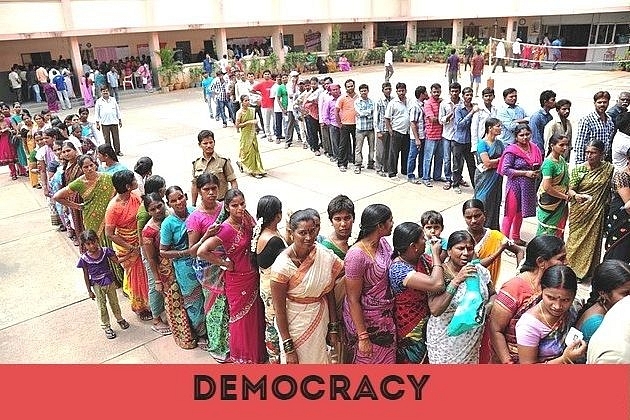News Brief
ECI Comes Out With Atlas On 2019 Polls, With A Host Of Data And Themes
- Consisting of 90 tables and 42 thematic maps depicting various facets of the elections, the Atlas has data of electors across different categories through various comparison charts like Elector Gender Ratio and electors in different age categories.

Citizens standing in queue to vote during election (Representative image)
Comprising all statistical figures and data of the last Lok Sabha polls, the Election Commission of India has released General Elections 2019: An Atlas.
Giving away interesting anecdotes, facts, and legal provisions regarding Indian elections, the Atlas has showcased data of the 23 States and UTs where the female voting percentage was higher than male voting percentage, and information about the smallest and largest parliamentary constituency in terms of candidates or electors, and performance of political parties amongst other parameters.
Consisting of 90 tables and 42 thematic maps depicting various facets of the elections, the Atlas has data of electors across different categories through various comparison charts like Elector Gender Ratio and electors in different age categories.
The lowest gender gap in the history of Indian elections was witnessed during the 2019 General Elections. The Elector Gender Ratio that was positive since 1971 recorded 926 during the 2019 General Elections.
Comparing the average number of electors per polling station in different states during the 2014 and 2019 General Elections, it said that over 10 lakh polling stations were set up in the 2019 General Elections by the Election Commission of India of which Arunachal Pradesh recorded the lowest number of electors per polling station (365).
The Atlas will also compare the number of candidates contesting in the General Elections since 1951. The 2019 General Elections recorded a total of 8,054 qualified candidates contesting.
The Election Commission in October 2019 released statistical reports based on the electoral records provided by the Returning Officers of 543 Parliamentary Constituencies.
Comprising tables and maps, the Atlas has provided information for a better understanding of Indian electoral diversity. These maps give insights into electoral patterns at different levels.
The Atlas has been prepared to serve as an illustrative and informative document that helps in understanding the nuances of the Indian electoral process and enables readers to analyse changes and trends in the country.
The Election Commission of India has been compiling electoral data in the form of statistical books and narratives since the first General Elections held in 1951-52.
In Indian elections, the electoral data is compiled during the preparation of the electoral rolls by Electoral Registration Officers and also during the process of elections by Returning Officers.
This data is further collated and after the elections are concluded, the Election Commission of India goes through the data and prepares various reports.
The 17th General Elections held in 2019 by far has been the largest democratic elections that recorded 61.468 voters at 10.378 lakh polling stations spread across 32 lakh-square kilometer territory of India.
Chief Election Commissioner Sushil Chandra along with Election Commissioner Rajiv Kumar and Election Commissioner Anup Chandra Pandey released the Atlas.
Applauding the work of the officers of the Commission for putting together this innovative document, Chandra said that this document would be beneficial to researchers and academicians in exploring the vast landscape of Indian elections.
Support Swarajya's 50 Ground Reports Project & Sponsor A Story
Every general election Swarajya does a 50 ground reports project.
Aimed only at serious readers and those who appreciate the nuances of political undercurrents, the project provides a sense of India's electoral landscape. As you know, these reports are produced after considerable investment of travel, time and effort on the ground.
This time too we've kicked off the project in style and have covered over 30 constituencies already. If you're someone who appreciates such work and have enjoyed our coverage please consider sponsoring a ground report for just Rs 2999 to Rs 19,999 - it goes a long way in helping us produce more quality reportage.
You can also back this project by becoming a subscriber for as little as Rs 999 - so do click on this links and choose a plan that suits you and back us.
Click below to contribute.
Latest